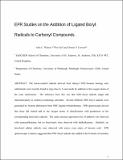Files in this item
EPR studies on the addition of ligated boryl radicals to carbonyl compounds
Item metadata
| dc.contributor.author | Walton, John C. | |
| dc.contributor.author | Dai, Wen | |
| dc.contributor.author | Curran, Dennis P. | |
| dc.date.accessioned | 2021-02-14T00:39:37Z | |
| dc.date.available | 2021-02-14T00:39:37Z | |
| dc.date.issued | 2020-03-20 | |
| dc.identifier | 267189819 | |
| dc.identifier | 9ed52017-ddf7-47f2-a2d6-78e8652c2213 | |
| dc.identifier | 85082143456 | |
| dc.identifier | 32056434 | |
| dc.identifier | 000526405900026 | |
| dc.identifier.citation | Walton , J C , Dai , W & Curran , D P 2020 , ' EPR studies on the addition of ligated boryl radicals to carbonyl compounds ' , The Journal of Organic Chemistry , vol. 85 , no. 6 , pp. 4248-4255 . https://doi.org/10.1021/acs.joc.9b03420 | en |
| dc.identifier.issn | 0022-3263 | |
| dc.identifier.other | ORCID: /0000-0003-2746-6276/work/71559549 | |
| dc.identifier.uri | https://hdl.handle.net/10023/21428 | |
| dc.description | J.C.W. thanks EaStCHEM for financial support and D.P.C. thanks the US National Science Foundation. Computational support was provided through the EaStCHEM Research Computing Facility. | en |
| dc.description.abstract | The boron-centered radicals derived from alkenyl N-heterocyclic carbene (NHC)-boranes bearing ester substituents were recently found to ring close in 5-endo mode by addition to the oxygen atoms of the ester substituents. The inference from this was that NHC-boryl radicals might add intermolecularly to carbonyl-containing substrates. Several different NHC-boryl radicals were generated by H-atom abstraction from NHC-ligated trihydroborates. Electron paramagnetic resonance (EPR) spectroscopy proved that these did indeed add to the oxygen atoms of diaryl ketones with production of the corresponding bora-ketyl radicals. The same unusual regioselectivity of addition was observed with monoaryl ketones, but no bora-ketyls were observed with dialkyl ketones. Similarly, no bora-ketyl adduct radicals were observed with esters, even esters of benzoic acid. EPR spectroscopic evidence suggested that NHC-boryl radicals were also added to the O-atoms of aromatic aldehydes. Amine-boryl and phosphine-boryl radicals were also observed to add to the O-atom of benzophenone with production of the corresponding ketyl radicals. | |
| dc.format.extent | 8 | |
| dc.format.extent | 913771 | |
| dc.language.iso | eng | |
| dc.relation.ispartof | The Journal of Organic Chemistry | en |
| dc.subject | Hydrocarbons | en |
| dc.subject | Adducts | en |
| dc.subject | Ketones | en |
| dc.subject | Electron paramagnetic resonance spectroscopy | en |
| dc.subject | Aromatic compounds | en |
| dc.subject | QD Chemistry | en |
| dc.subject | Organic Chemistry | en |
| dc.subject | DAS | en |
| dc.subject.lcc | QD | en |
| dc.title | EPR studies on the addition of ligated boryl radicals to carbonyl compounds | en |
| dc.type | Journal article | en |
| dc.contributor.institution | University of St Andrews. School of Chemistry | en |
| dc.contributor.institution | University of St Andrews. EaSTCHEM | en |
| dc.identifier.doi | https://doi.org/10.1021/acs.joc.9b03420 | |
| dc.description.status | Peer reviewed | en |
| dc.date.embargoedUntil | 2021-02-14 |
This item appears in the following Collection(s)
Items in the St Andrews Research Repository are protected by copyright, with all rights reserved, unless otherwise indicated.

